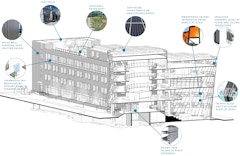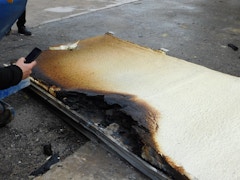
275 results
-
 The piezoelectric facade as a self-sustained technology can generate a considerable amount of energy by converting swaying motions (actuated by the…
The piezoelectric facade as a self-sustained technology can generate a considerable amount of energy by converting swaying motions (actuated by the… -

Paul Rudolph's Christian Science Building
- Paper by Scott Murray,
This paper presents new historical research on the concrete facade of an important but relatively unknown and now demolished building by the American… -

Form as Energy
- Paper by Matthew Fineout,
All too often, high-performance building envelopes are considered in terms of new materials and technologies that push specific systems to improve… -

Establishing a Life Cycle Assessment Methodology for Innovative Facade
- Paper by Vikki Lew
Life cycle assessment was introduced in the 1970s as an analytical tool to quantify the environmental impact of a product, process, or service.
-

Green Façade/Roofs Design Tool
- Paper by Abolfazl Ganji Kheybari, Researcher and Building Physics Expert Morteza Kasravi, Computer Scientist
Climate change and related thermal issues, draw attention to the impact of green facades and roofs on energy savings and thermal comfort. Besides, by… -

Sustainable Retrofit Strategies for an Existing Laboratory Building
- Paper by Suncica Milosevic · Ajla Aksamija
This paper analyzes sustainable retrofit strategies for an existing research laboratory building, located in a cold climate. This facility is
-
Mapping Advanced Facades
- Paper by David Russell Lehrer · Vito Lamberti
This paper describes the development of an interactive map that highlights case studies of advanced facade design strategies and technologies from
-

Facade Engineering for the Fourth Industrial Revolution
- Paper by Mikkel K. Kragh
What does the fourth industrial revolution mean to the design and engineering of facades of the future? We are experiencing a global technological
-

A Burning Question Revisited
- Paper by Stéphane Pierre Hoffman
In recent decades the use of unitized glazing systems has become increasingly common especially for high-rise construction. The opaque panels in
-

EUI of Building Clusters
- Paper by Srinivas M. Rao, AIA, AICP, LEED AP
Large master planned developments such as Battery Park City in Manhattan, Mission Bay in San Francisco, and Playa Vista in Los Angeles were built
-

Performance of Compact, Closed Cavity, Double-skin Curtain Wall
- Paper by Julien Schwartz, M. Eng., Building Energy Consultant Katie Hay, P. Eng., Building Science Consultant Stéphane Hoffman, M. Arch., M. Eng, PE, Vice President, Building Science Analytics
A proposed design for a compact, closed cavity, double-skin curtain wall system in the Marine climate of the West Coast raises questions of potential… -

Multi Layer Facades
- Paper by Robert Moisy,
The history of high performance facades and glazing has been a tale of attempting to manage the conflicting requirements of, on one hand inviting… -

Carbon-Dioxide-Inhaling Facade
- Paper by Prof. Dr. Timo Schmidt, Professor for facade technology and design Carmen Herrmann, Student Dr. Michael Lakatos, Professor Daniel Zabicki, Scientific Employee Prof. Dr.-Ing. Michael Wahl, Professor Kai Scherer, PhD Student
3.5 billion years ago, cyanobacteria created the foundation for life on Earth by producing the oxygen basis for our atmosphere. Should we once again… -
Facades for High-Performance Workplaces
- Paper by Christopher Payne, AIA, LEED AP, Assoc. DBIA
How has the role of the façade evolved in light of the COVID-19 pandemic and ongoing fight to combat the climate change crisis? As companies grapple
-

Façade Systems and Embodied Carbon
- Paper by Paulina Szpiech · Valerie Leon-Green · Shivanie Rambaran
Life Cycle Assessment (LCA) is a methodology used to quantify the impact of building construction supply chains on the environment in terms of
-

Thermal Performance of Closed Cavity Facades
- Paper by Andrea Zani · Carmelo Guido Galante · Lisa Rammig
Closed cavity facades (CCF), a configuration of Double Skin Facade (DSF), consists of a double-glazed unit on the inner layer and single glazing on
-
Reglaze or Replace?
- Paper by Angel Ayón, AIA, LEED AP · Laura Boynton, AIA, LEED AP
Originally known as The Master Building, 310 Riverside Drive in Manhattan's Upper West Side is a 28-story tower completed in 1929 as an apartment
-

U-Factor Matters in Hot Climates
- Paper by Helen Sanders, PhD, General Manager
It is commonly thought that fenestration U-factor is not a key determinant in the performance of facades in hot climates, and generally the focus of… -

The Performative Double-Skin
- Paper by Jeffrey Abramson, AIA, LEED AP, Associate Principal Alejandra Menchaca, PhD, LEED AP, WELL AP, Vice President
Double-Skin Facades (DSF) are well-known to boost the thermal performance of a façade: they can provide extra insulation in the wintertime and lower… -

Highly Efficient Façades with Innovative Shading and Light Control
- Paper by Klaus Reuschle · Robert Matthew Noblett · Michelle Siu-Ching Lee · Roman Schieber
The Science and Engineering Complex (SEC) on the Allston Campus is the largest new building at Harvard University in recent decades with a footprint